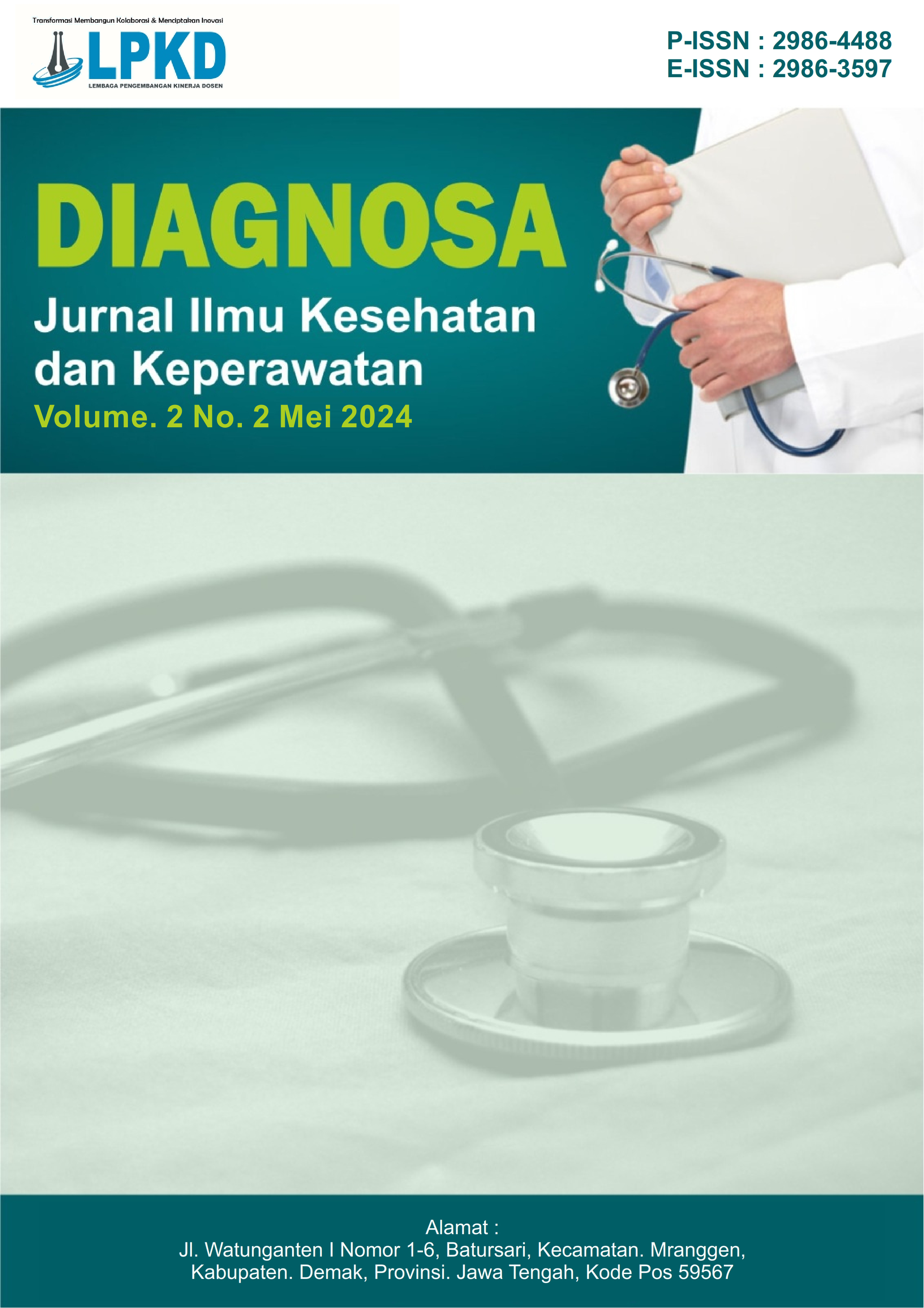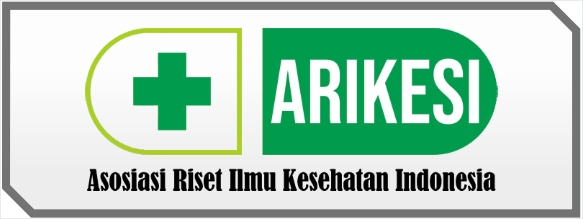Analisis Karakteristik Ibu Terhadap Pengetahuan Tentang Pemberian MPASI Rumahan Dan MPASI Pabrikan Di Bidan Praktik Mandiri Di Wilayah Puskesmas Kotabaru Bekasi Barat
DOI:
https://doi.org/10.59581/diagnosa-widyakarya.v2i2.3108Keywords:
Characteristics, MP-ASI, KnowledgeAbstract
Complementary food (MP-ASI) is very important for babies after the age of 6-24 months, because breast milk no longer provides the nutrients needed. In this case, the mother's knowledge of MP-ASI is very influential. The relationship between maternal characteristics and knowledge about providing MP-ASI includes maternal knowledge, maternal age, maternal education, maternal occupation and family income. The aim of the research is to analyze the relationship between maternal characteristics and knowledge about giving local breast milk and manufactured breast milk to babies aged 6 - 24 months in independent practice midwives in the working area of Kotabaru Health Center, Bekasi City in 2023. This research uses Observational Analytical research with a Cross-Sectional research design. The population in this study were mothers who had babies aged 6-24 months in Independent Practice Midwives in the Kotabaru Health Center Work Area, Bekasi City, totaling 99 respondents. The sample used was total sampling. The instrument used in this research is a structured interview which is guided by a checklist which has been tested with validity and reliability tests. The research results from a sample of 99 respondents showed that 70 respondents (70.7%) gave high levels of MP-ASI, 24 respondents (24.2%) gave moderate MP-ASI, and 5 respondents gave low levels of MP-ASI. respondents (5.1%). The chi square test with a significance level of 95% or ɑ = 0.05 obtained a value of p = 0.038 < 0.05. This shows that there is a relationship between maternal knowledge and the provision of MP-ASI to babies aged 6-24 months in independent practice midwives in the working area of Kotabaru Health Center, Bekasi City in 2023.
References
Banjarmasin, M., & Asuh, P. (2021). Hubungan Pola Asuh Ibu dengan Kejadian Stunting Anak Usia 12-59 Bulan. Jurnal Ilmu Keperawatan Anak, 4(1), 37–42. https://doi.org/10.32584/jika.v4i1.959
Csölle, I., Felső, R., Szabó, É., Metzendorf, M. I., Schwingshackl, L., Ferenci, T., & Lohner, S. (2022). Health outcomes associated with micronutrient-fortified complementary foods in infants and young children aged 6–23 months: a systematic review and meta-analysis. The Lancet Child and Adolescent Health, 6(8), 533–544. https://doi.org/10.1016/S2352-4642(22)00147-X
Dinkes, K. bekasi. (2020). Profil Kesehatan Kota Bekasi Tahun 2020. Dinas Kesehatan Kota Bekasi, 5(3), 248–253.
Estiasih, T., Ahmadi, K., Dewanti Widyaningsih, T., Rhitmayanti, E., Fidyasari, A., Purnomo, K., & Wahyuni, Y. (2014). The Effect of Unsaponifiable Fraction from Palm Fatty Acid Distillate on Lipid Profile of Hypercholesterolaemia Rats. Journal of Food and Nutrition Research, 2(12), 1029–1036. https://doi.org/10.12691/jfnr-2-12-26
Fitriani, Barangkau, Masrah Hasan, Ruslang, Eka Hardianti, Khaeria, Resti Oktavia, & Selpiana. (2022). Cegah Stunting Itu Penting! Jurnal Pengabdian Kepada Masyarakat (JurDikMas) Sosiosaintifik, 4(2), 63–67. https://doi.org/10.54339/jurdikmas.v4i2.417
Harrison, L., Padhani, Z., Salam, R., Oh, C., Rahim, K., Maqsood, M., Ali, A., Charbonneau, K., Keats, E. C., Lassi, Z. S., Imdad, A., Owais, A., Das, J., & Bhutta, Z. A. (2023). Dietary Strategies for Complementary Feeding between 6 and 24 Months of Age: The Evidence. Nutrients, 15(13). https://doi.org/10.3390/nu15133041
Hati, F. S., & Pratiwi, A. M. (2019). The Effect of Education Giving on The Parent’s Behavior About Growth Stimulation in Children with Stunting. NurseLine Journal, 4(1), 12. https://doi.org/10.19184/nlj.v4i1.8628
Kemenkes. (2022). Buku Saku Hasil Survey Status Gizi Indonesia (SSGI) Tahun 2022. Kemenkes, 1–7.
Kristiyanti, R., Khuzaiyah, S., & Susiatmi, S. A. (2021). Gambaran Pengetahuan tentang Stunting dan Sikap Ibu dalam Mencegah Stunting. Sekolah Tinggi Ilmu Kesehatan Muhammadiyah Klaten, 1043–1046.
Laksono, A. D., Wulandari, R. D., Amaliah, N., & Wisnuwardani, R. W. (2022). Stunting among children under two years in Indonesia: Does maternal education matter? PLoS ONE, 17(7 July), 1–11. https://doi.org/10.1371/journal.pone.0271509
Lassi, Z. S., Rind, F., Irfan, O., Hadi, R., Das, J. K., & Bhutta, Z. A. (2020). Impact of infant and young child feeding (Iycf) nutrition interventions on breastfeeding practices, growth and mortality in low-and middle-income countries: Systematic review. Nutrients, 12(3). https://doi.org/10.3390/nu12030722
Lutter, C. K., Grummer-Strawn, L., & Rogers, L. (2021). Complementary feeding of infants and young children 6 to 23 months of age. Nutrition Reviews, 79(8), 825–846. https://doi.org/10.1093/nutrit/nuaa143
Nasution, I. S., & Susilawati. (2022). Analisis Faktor Penyebab Kejadian Stunting Pada Balita Usia 0-59 Bulan. Ilmiah Kesehatan, 1(2), 1–6.
Pasundan, U., Info, A., Empowerment, W., & Stunting, R. (2024). Empowering Women as Agents of Change in reducing Stunting in Indonesia. 14(02), 104–112. https://doi.org/10.58471/justi.v14i02
Pérez-Escamilla, R., Tomori, C., Hernández-Cordero, S., Baker, P., Barros, A. J. D., Bégin, F., Chapman, D. J., Grummer-Strawn, L. M., McCoy, D., Menon, P., Ribeiro Neves, P. A., Piwoz, E., Rollins, N., Victora, C. G., & Richter, L. (2023). Breastfeeding: crucially important, but increasingly challenged in a market-driven world. The Lancet, 401(10375), 472–485. https://doi.org/10.1016/S0140-6736(22)01932-8
Wati, S. K., Kusyani, A., & Fitriyah, E. T. (2021). Pengaruh faktor ibu ( pengetahuan ibu , pemberian ASI- eksklusif & MP-ASI ) terhadap kejadian stunting pada anak. Journal of Health Science Community, 2(1), 13.
Downloads
Published
How to Cite
Issue
Section
License
Copyright (c) 2024 DIAGNOSA: Jurnal Ilmu Kesehatan dan Keperawatan

This work is licensed under a Creative Commons Attribution-ShareAlike 4.0 International License.













